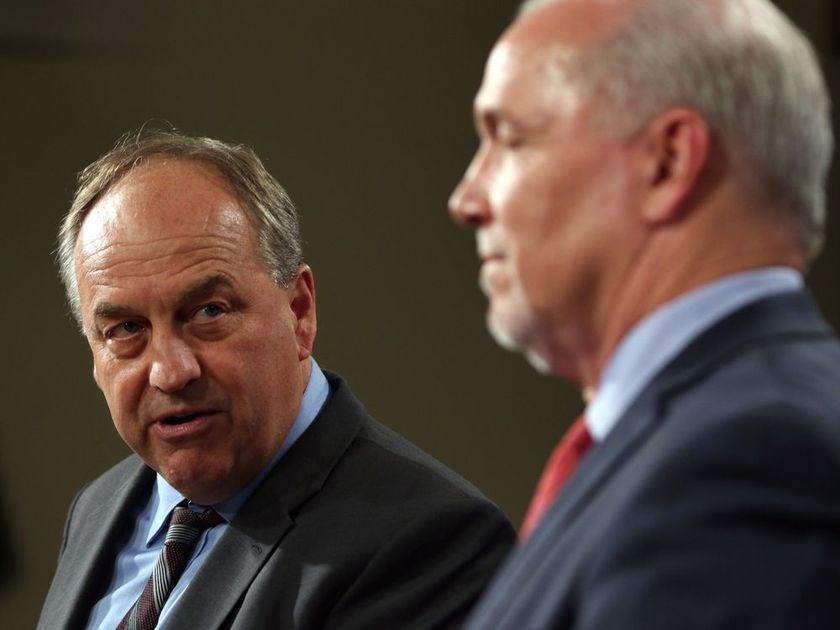VANCOUVER — A thriving liquid natural gas industry in B.C. would require a 50-per-cent reduction in greenhouse gas emissions from every other sector of the economy in order to meet the province’s 2030 climate goals, according to B.C. Green Party Leader Andrew Weaver.
“Emissions would have to be cut, not just by industry, but in every part of the economy,” said Weaver in a radio interview. “I do not believe that is possible.”
LNG Canada is proposing to build a $40-billion LNG pipeline and plant in Kitimat. A smaller second plant is planned on Howe Sound.
In a letter to LNG Canada CEO Andy Callitz, Weaver warned that reaching B.C.’s greenhouse gas reduction goals “must be done in a way that limits harm to other existing industries that provide jobs and economic activity that British Columbians rely on.”
“If we are going to meet our legislated targets and LNG is going to bring on this huge increase every year for the next 40 years, everyone else will have to cut their emissions by half by 2030 and 95 per cent by the year 2050,” said Weaver.
Fossil fuel production produces about 12 million tonnes of CO2 a year in B.C., according to government figures.
Weaver says the proposed plant will release another eight to 10 million tonnes a year, a figure the company hotly denies.
The LNG Canada plant at full capacity would produce 26 million tonnes of liquid natural gas each year and release four million tonnes of carbon dioxide, according to company spokeswoman Susannah Pierce.
The company is planning a hybrid facility in which hydroelectric power is used for all auxiliary needs and gas-powered turbines for the core liquefaction process.
“We have achieved the lowest carbon intensity of any large LNG plant in the world,” she said. “The industry average is about 0.26 (tonnes of carbon) per tonne of LNG — we are much lower, about 0.15.”
Using all-electric technology for the core liquefaction process would have required a “ridiculous” 1,000 megawatts of electricity — more than five per cent of the entire production of B.C. Hydro — plus the construction of a $1-billion transmission line.
Producing low-carbon LNG in Canada is a net benefit to the world, when it displaces other more carbon-intensive fuels such as coal, said Pierce.
But that won’t help the NDP politically.
In order to meet the 2050 climate target, B.C. would have to reduce its emissions by more than 50 million tonnes of carbon dioxide from our current level of about 64 million tonnes.
The entire transportation sector, including personal vehicles, releases about 25.5 million tonnes of CO2 annually, about 40 per cent of our total, according to the B.C. Greenhouse Gas Inventory.
“The lowest-hanging fruit is transportation and with electrification we would be well on our way to meeting our (2030) goal, but add in LNG and you can forget it,” said Weaver.
The province is already behind on its 2020 target to cut greenhouse gas emissions by 33 per cent below 2007 levels, and emissions have even crept up rather than down in recent years. And Weaver is seeking more, or he will withdraw his support of Premier John Horgan’s minority government.
“Right now, we have demanded to see a climate plan that shows a clear path to a 40-per-cent reduction by 2030 and 80 per cent by 2050,” said Weaver.
The province’s greenhouse gas emission targets are “arbitrary” and miss the point of Canada’s commitment to the Paris Accord, which is to hold global warming to no more than two degrees Celsius above pre-industrial levels, said Greg D’Avignon, president and CEO of the Business Council of B.C.
B.C. is ahead of the rest of the world in environmental regulation, implementation of a carbon tax and using low-carbon power, hydroelectric and other renewable energy sources, he said.
“Demand for energy is going to go up 30 per cent by 2040. We need metals for batteries and smart devices, and B.C. has the lowest-carbon sources of these things of any country in the world,” he said.
“If we care about the world, we need to sell these things as low-carbon inputs and do some good outside the boundaries of B.C.”



